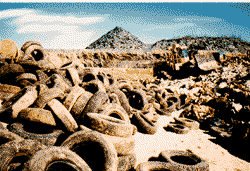LowFlow Showerheads are mandatory but once you start there is serious stuff you can do to save water. Cisterns. It used to be that everyone had them. Some were as simple as a hole in the ground covered with screening. Sometimes they were even built as part of the house. Sort of your own personal water tower. But with the advent of modern drinking water systems they fell by the wayside.
http://www.harvesth2o.com/plumbing_codes.shtml
History
Cisterns are an ancient technology. In the Middle East in 2000 B.C., typical middle-class dwellings stored rainwater in cisterns for use as a domestic supply as well as private- bathing facilities for the wealthy.
The world’s largest cistern may be the Yerebatan Sarayi. On the European side of Istanbul in Turkey, it was constructed under Caesar Justinian (A.D. 527-565) and measures 140 by 70 meters. It can store 80,000 m³ water. The underground structure is based on intersecting vaults. Today, it is a tourist attraction which is visited by boat, drifting through a forest of columns. Another cistern in Istanbul is called Binbirdik, believed by some sources to have been constructed under Caesar Constantine (A.D. 329-337), with a capacity of 50,000 m³. Each cistern served as centralized storage for water collected from roofs and paved streets and featured a sophisticated system of filters that assured clean water.
These municipal underground cisterns may be the only examples of urban centralized rainwater harvesting of their kind. This technique was likely abandoned for two primary reasons: 1) the construction of underground cisterns is considerably more expensive than the construction of dams; 2) there is a danger of accidental pollution through human excrement in dense urban areas and a corresponding risk of epidemics.
Water Classifications
Harvested rainwater is shrouded in confusion. Some jurisdictions consider it reclaimed water and others refer to it as gray water. Actually, it is neither. To clarify, UPC offers the following definitions.
• Black water is toilet waste.
• Gray water is untreated wastewater that has had no contact with toilet waste such as used water from bathtubs, showers, lavatories and water from washing machines. It does not include wastewater from kitchen sinks or dishwashers.
• Reclaimed water is water which, as a result of tertiary treatment of domestic wastewater by a public agency, is suitable for controlled use. The controlled use can be the supply of reclaimed water-to-water closets, urinals and trap seal primers for floor drains and floor sinks. In areas under the jurisdiction of the UPC this system is usually called a “purple pipe” system because the reclaimed water is conveyed in pipe that is purple.
• Harvested rainwater is storm water that is conveyed from a building roof, stored in a cistern and disinfected and filtered before being used for toilet flushing. It can also be used for landscape irrigation.
As noted, Appendix J of the UPC describes reclaimed water, but according to the above definition, rainwater harvesting is not reclaimed water. Plumbing officials who do not know how to classify rainwater-harvesting systems consider them reclaimed water systems and therefore require plumbing engineers to design systems that conform to Appendix J of the UPC. This is because of the lack of guidance in the code. Since these systems are becoming more prevalent in the U.S., both the UPC and the IPC must include a section dedicated to rainwater harvesting.
Rainwater Harvesting Basics
The components of the rainwater-harvesting system include:
Roof. Rainwater should only be collected from a roof and stored in a cistern. Rainwater runoff from parking areas and other outdoor surfaces typically contain harsh chemicals and other contaminants that are undesirable in a rainwater catchment system.
Rainwater conductors. Leaders and gutters or an internally piped roof drainage system that conveys the storm water from the roof to the cistern.
Cistern. A storage tank that allows large particulate matter to settle out of the water.
Overflow from cistern. A pipe that takes overflow from the cistern to the storm drainage system.
Pumping system. Provides the pressure required at the fixture most distant from the tank.
Disinfection system. Various filtration and disinfection systems can be used.
Potable water makeup. Makeup water provided to the tank during dry seasons. Appropriate backflow prevention is required.
:}
But this is to CODE which may or may not apply…First you have to figure out where you are going to put the water.
:}
http://www.braewater.com/index.php?/solutions/
Rainwater Harvesting
As much as 60,000 gallons of precipitation falls on a 2,000 square foot roof in Mid-Atlantic States each year. BRAE distributes Complete rainwater harvesting system solutions to put this water to beneficial use. Rainwater harvesting systems offset demands on municipal and private water supplies for outdoor watering while conserving valuable drinking water resources.
The concept of collecting and using rainwater is not new.
In addition to the advantages that rainwater is free of charge, it doesn’t have to be treated nor transported over long distances, the two most important arguments supporting the utilization of rainwater are:
1. Supplement drinking water resources
-with the benefit of saving precious potable water
2. protecting water quality by reducing impacts of stormwater runoff
-with the benefit of limiting flooding and degradation of streams and lakes
Thanks to its characteristics the use of rainwater also has positive advantages:
-Ideal for plant growth
-Better washing efficiency -up to 50% less detergent required when compared with hard water
-No calcification of fixtures and washing machines
All projects are not created equal and thus rainwater systems do not conform to a “one size fits all” sales format. There are different systems for two primary types of rainwater systems residential and commercial. Use the following resources to design and select the right system for your project.
Residential systems generally supply rainwater to toilets, washing machines, garden irrigation and hosebibs (ie car washing)
http://www.braewater.com/index.php?/products/tanks_cisterns/
Tanks/Cisterns
Water storage is the most critical component of a rainwater system. In selecting a water storage tank or cistern, there are several important questions you should ask before selecting the right tank for your project.Ask yourself…
Will I store the water above ground or below ground?
How much storage do I need?
Are there space limitations that restrict the size of water tank I may chose?
What appearance do I want for my tank?
Will the neighbors care?
Are there restrictions regarding water storage tanks?
Is my site accessible or hard to reach with a delivery truck?
:}
:}





